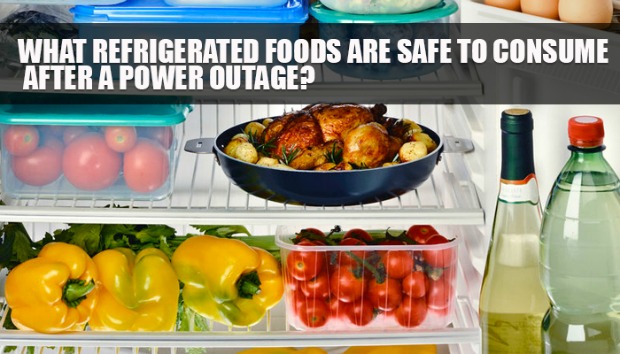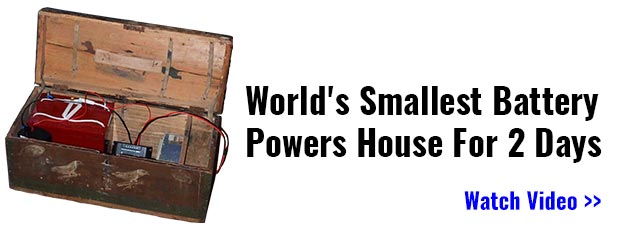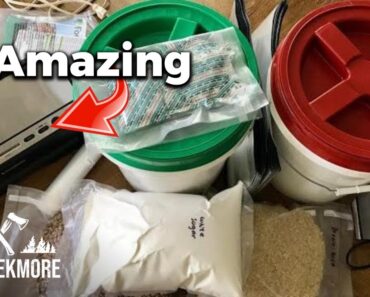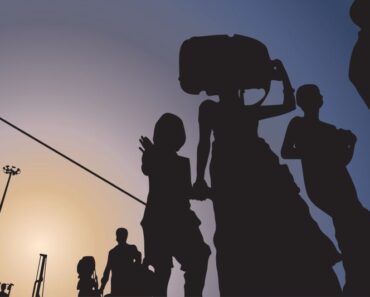Our power grid is fragile, and we’ve all seen what years of neglect, underfunding and political games can lead to.
Power outages and extended blackouts have become the new normal, and folks seem unfazed by these common occurrences since often, it’s just a matter of time until things get back to normal.
However, the increase in extreme weather events such as storms, excessive heat waves, and blizzards should put some common sense into folks since severe weather could leave them without power for days, if not weeks. Unfortunately, seeing how unreliable the US power grid is, there’s no guarantee that “things will get back to normal,” and one day, that typical outage may turn into something worse.
Click HERE to Get the World’s Smallest Battery, That Powers Your House For More Than 2 Days!
This article will cover the most common emergency lighting options we have at hand to brighten even the darkest of blackouts. Since there are many lighting products available on the market, you need to be smart about picking your emergency lighting items, whether they are long-term or short-term solutions.
Traditional battery-powered flashlights
In every American household, there is at least one classic flashlight waiting to be used. Some may be in reach, while others may harbor dead batteries and are buried under a pile of supplies. With the vast array of flashlights available nowadays, one can pick a trustworthy Jet Beam 6000-lumen flashlight or a cheap, poorly made Chinese flashlight that can still do its job if you manage to find it in time.
- Pros – Flashlights are easy to use, and even children can operate one safely without complications. They are the first item that comes into mind during a blackout, and it becomes your first line of defense. The LED technology improved the classical flashlight considerably, making it brighter and more efficient than twenty years ago.
- Cons – The battery life and light output vary significantly from one model to another, and manufacturers have different performance standards. As a result, a flashlight is not an ideal solution for your long-term lighting needs, and it’s mainly a means to find your way through the dark.
- My two cents – The cost of the average flashlight is neglectable, but higher-end models can draw hundreds of dollars from your prepping budget. I have more than one flashlight, but all of them run on the same type of battery. Keep this in mind when purchasing a flashlight since you won’t have to worry about stockpiling different batteries. Having suitable batteries on hand will make sure all your flashlights will work when needed.
Also, please keep them in reach and return the flashlights to their designated places after you’re done using them.
Rechargeable flashlights
These flashlights have a hand-crank mechanism or a small solar cells section embedded that makes them just what you’d expect, rechargeable flashlights using renewable power instead of batteries. I have a hand-cranked model, and around five minutes of cranking provides a decent amount of lighting.
I also have a few solar flashlights that require to be charged for the better part of the day, but they provide several hours of light, much more than the hand-cranked type. However, you can imagine that if they run out of juice at night, your best bet to light the way will still be the hand-cranked flashlight.
- Pros – The hand-cranked flashlight provides a decent amount of time and a light workout (they can also keep your kids busy). The solar-powered ones are an excellent short-term lighting option if you don’t forget to recharge them. Both are a great addition to your prepping plan, especially if you run short on batteries.
- Cons – Not ideal if you need immediate lighting since you need to power the flashlights before use. Solar flashlights might do the trick if the weather has been sunny and if you remembered to charge them.
- My two cents – The quality of these flashlights varies greatly, and you have to pick a manufacturer you trust if you don’t want to regret your purchase. The most basic models are cheap, but the ones with radio, cell-phone chargers, and other conveniences can be pretty expensive. Such flashlights are handy to have given their versatility, but you need to make sure you bought some quality items once again.
Headlamps
Today’s headlamps have gone a long way since the era of the old-timey miners, and thanks to the LED bulbs, they are much brighter and easy to use. One of their best features, in my opinion, is the addition of red/green LED bulbs that preserve your night vision when using them. Toppled with the hands-free capabilities, headlamps remain one of my favorite options for camping, especially when I have to take care of nocturnal chores.
- Pros – They have a decent light output (up to 150 lumens), and they provide the luxury of using both hands during a blackout. As a result, they are ideal for nighttime travel and work.
- Cons – Some are short-lived, and you need to consider carrying a spare of batteries. Even more, some headlamps require batteries that are not so common, and you may have to adjust your battery stockpile accordingly.
- My two cents – Headlamps are ideal for those on the go since they are simple to use and relatively cheap. Even the most expensive models are less than $50. In addition, having a headlamp provides you the luxury of using both your hands for various chores, and you won’t have to lug around a flashlight anymore.
Glow sticks
Chemical glow sticks are a temporary lighting solution because they are simple and easy to come by. However, they are just a short-term solution and a fun novelty at best since they are inexpensive.
- Pros – They are a one-off purchase that won’t break the bank, and they are the cheapest emergency lighting options (excluding candles).
- Cons – They have low light output, and their overall usefulness is limited since you can’t turn them off. In addition, most of the glow sticks you can buy are not reusable, and you have to dispose of them properly.
- My two cents – I usually avoid these types of items, although I’ve used some glow sticks in the past during my camping trips to entertain my nephews. However, if you want to add these to your emergency supplies, I recommend you reconsider and try the rechargeable glow sticks instead.
Reusable glow sticks
The battery-powered or rechargeable glow sticks are far better than the chemical ones since they provide a decent amount of light. Some models contain crystals that can absorb light during the day and glow all night due to a chemical process. These reusable glow sticks are more expensive than their classical counterparts, but they are still inexpensive compared to flashlights or other emergency lighting items.
- Pros – They provide a decent amount of light, and I’ve used the Lifegear LED model to get by at my campsite at night without problems. The light output is dependent on batteries, but some models are better and long-lasting compared to others.
- Cons – They do not provide the amount of light needed to illuminate a room correctly, and they can prove problematic during an extended disaster when good lighting is required.
- My two cents – If you want to give rechargeable glow sticks a try, I recommend the UV Paqlite since, in my opinion, these are the best on the market. They may be a great long-term lighting solution, provided you don’t need to light up an entire room completely.
Double-mantle propane lanterns
These lanterns are designed so that everyone can screw in a propane tank to provide the much-needed light during an extended blackout. These can be considered “plug and play” since you can easily swap out used tanks, and they are pressure regulated to provide consistent lighting.
These can be considered somewhat expensive compared to battery-operated or kerosene lanterns. Still, seeing that propane is cheap and it’s easier to find than kerosene, they are a worthy candidate for your emergency lighting planning.
- Pros – Simple and easy to use, these landers provide a bright light unmatched during extensive blackouts. There is little smoke or soot, and you can extend the use of your propane lantern by using the lowest setting (I managed to get 12 hours out of one of these).
- Cons – Sometimes, you need to replace the mantles. When you have to tie the mantles onto the burners, the first time you use them can prove troublesome for some folks.
- My two cents – The low cost of propane and the simple maneuverability of double-mantle propane lanterns make them an ideal candidate for extended power outages. There are various brands on the market, and if you manage to take advantage of the various yearly sales, you won’t regret the purchase.
Battery-powered camping lanterns
There are various models on the market that have changed the way people see camping lanterns. Thanks to LED technology advancements, the battery-operated camping lanterns you can buy today are much lighter and brighter than their ancestors. And unlike their fuel-burning predecessors, the new, inexpensive camping lanterns do not produce carbon monoxide.
- Pros – Easy to use with a constant and bright light. They are ideal for emergencies since they do not produce CO, and you can find them for cheap at thrift stores and the like.
- Cons – Some camping lanterns can be pretty bulky even with the new LED technology embedded. This makes them a somewhat secondary option for your bug-out planning, as you may need something lighter.
- My two cents – The battery-operated lanterns can be ideal for indoor and outdoor use during a blackout since they provide bright light. However, when purchasing one or more of these lanterns, make sure they use the same batteries and that you’ve got a proper buttery supply at home.
Kerosene lanterns
You’ve seen many kerosene lamps in discount stores, and the average ten-dollar kerosene lamp can still be found in the American home. They are a relatively inexpensive option when it comes to emergency lighting.
- Pros – Cheap and easy to set up, but most importantly, they are easy to transport. Even more, some lamps can use citronella oil as fuel.
- Cons – Low light output compared to other items, and they produce black smoke. Therefore, the wick needs to be maintained and checked regularly. Also, since they make CO, the lamp should be used only outdoors.
- My two cents – The light output is not as bright as the one from other emergency lighting items listed here, and many see these lamps as fuel-powered candles. Nevertheless, they are not a bad option when facing a blackout, provided you have taken care of the downsides of such items.
Candles
Candles were, and remain, one of the primary artificial lighting sources used worldwide, even in this age when technology rules our lives. They are still useful today because they are cheap, low-tech and you can always count on them no matter what.
Some like to make their candles while others buy them for the general stores. Even survival varieties can last for many hours, and they are gaining a lot of popularity among preppers and survivalists.
- Pros – Incredibly inexpensive, especially if you shop in the clearance section. They are easy to transport, and they only require a fire source to function. Some of the survival varieties can last for almost thirty hours, and a good supply of such candles can cover your emergency lighting needs for months to come.
- Cons – Candles remain a severe fire risk, and caution is required when using them indoors and outdoors. If you have children and/or pets, you need to make sure they do not interact with the candles. Candles do not provide a great deal of light, so it would not be easy to properly light up the entire living room. They are useless as a bug-out emergency lighting option.
- My two cents – Having a stash of candles is a good and inexpensive option to cover your lighting needs during an extended blackout. However, candles should never be your primary option to produce light, and you should rely on safer methods to light up a room. They are a constant fire hazard, and you have to use them properly to avoid housefires.
Concluding
The emergency lighting options listed in this article can come in handy if a regional blackout hits, but you should pick only the items that are right for your needs. You have all the info to make an intelligent choice, so keep in mind the pros and cons of each when you build your backup plan.






























